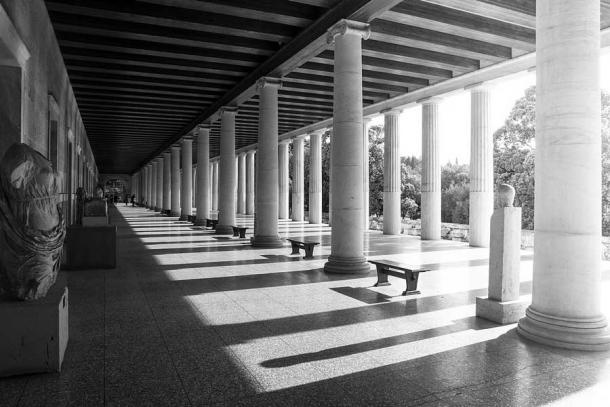The Stoa of Attalos (also spelled Attalus) is a monument that was once part of the ancient Agora of Athens. This stoa was built along the eastern edge of the agora, and dates to the 2nd century BC. This monument was named after King Attalos II of Pergamon, who gifted it to the people of Athens. The Stoa of Attalos was destroyed during the 3 rd century AD but was later rebuilt in the 1950s. This reconstruction still stands today, and currently houses the Agora of Athens Museum.
In ancient Greek architecture, a stoa is a covered walkway or portico supported by columns. The Stoa of Attalos, is one of the more famous ancient stoas. This stoa was a gift from Attalos II, the King of Pergamon, to the Athenians. The king had spent some time studying under the philosopher Karneades in Athens. To show his appreciation for the city, he decided to build this magnificent stoa.

A view of the Stoa of Attalos from the Acropolis hill in Athens. (A.Savin (Wikimedia Commons WikiPhotoSpace) / CC BY-SA 3.0 )
What The Stoa Of Attalos Was And What Happened To It
The Stoa of Attalos measures 115 m (337 ft) by 20 m (65 ft) and was built using Pentelic marble (for the façade and columns) and limestone (for the walls), both of which were locally available. The Stoa of Attalos, like other stoas of the same period, was an elaborate monument. It had two stories and a double colonnade. Behind the columns were shops, 42 in total, 21 for each floor. Thus, the Stoa of Attalos was a major commercial building in the city and an ancient kind of shopping mall.
Since the agora was a public space, the Stoa of Attalos was not only a shopping area, but also a place where the ancient Athenians could gather to socialize. Indeed, as a covered walkway, the stoa provided shade from the summer heat, as well as from the winter rain and wind, thus making it an ideal place for public gatherings.
The Stoa of Attalos was in use for centuries, until it was destroyed in 267 AD by the Herulians, a Germanic people who were raiding Roman provinces in the Balkans and Aegean.
The ruins of the stoa were subsequently incorporated into a new fortification wall, which saved it from further destruction, and helped preserve its northern end up until the level of the roof. In the centuries that followed, the ruins of the stoa led a quiet existence in its new role as part of the fortification wall. Although the stoa had always been visible, thanks to the preservation of its northern end, it seems that it was largely forgotten.

The Stoa of Attalos portico at sunset. (Georgios Liakopoulos / CC BY-SA 3.0)
How The Stoa Of Attalos Was Reconstructed And Reopened
It was only during the second half of the 19 th century that the Stoa of Attalos received some attention. Between 1859 and 1862, and again in 1898 and 1902, the Greek Archaeological Society cleared the debris that had accumulated on the ruins of the stoa. Later, the stoa was excavated by the American School of Classical Studies at Athens. This was part of a larger project, i.e., the excavation of the ancient Agora of Athens, which had commenced in 1931.
In the modern history of the Stoa of Attalos the year 1953 was transformational. The reconstruction of the monument began in that year. Overall, 150 workmen, including 50 master masons, 20 carpenters, and 5 steelworkers, were employed for the project. Since the new structure was to be built using materials as close as possible to the original structure, quarries in Piraeus and Mount Penteli were reopened.
In some parts of the reconstruction, the ruins were incorporated into the new structure. In others, where only the foundations remained, the reconstruction was built directly on top of them. Nevertheless, representative pieces were included, so that visitors could determine for themselves if the reconstruction is accurate.
The reconstruction of the Stoa of Attalos was completed three years later, in 1956, and was dedicated on the 3 rd of September that year. Since then, the site has been home to the Agora of Athens Museum, the exhibits of which are mainly focused on ancient Athenian democracy. The gallery on the ground floor of the stoa contains artefacts unearthed during the excavations by the American School of Classical Studies in Athens at the agora. The artefacts date from the Neolithic period all the way to the Ottoman period .

Statue of Hercules on display at the Agora of Athens Museum, which is located in the Stoa of Attalos. (Юкатан / CC BY-SA 3.0 )
The second story of the stoa used to house excavation offices, workrooms, archives, and was used as a space for additional storage. In 2012, a new exhibition was inaugurated on the stoa’s upper floor. This exhibition is divided into six units, and contains a collection of Athenian sculptures , the most significant of which being a group of portraits from the excavations of the agora.
Incidentally, the Stoa of Attalos was the site where the Treaty of Accession 2003 was signed between the member states of the European Union and 10 countries concerning the latter’s accession into the European Union.
Today, the Stoa of Attalos is opened to the public, as it was in ancient times. Tickets, however, are required for entry into the monument, though there are a number of days throughout the year when free admission is granted to the public.
Top image: The Stoa of Attalos in Athens as it looks today after being reconstructed in the 1950s. Source: Kritheus / CC BY-SA 4.0
By Wu Mingren
Related posts:
Views: 0
 RSS Feed
RSS Feed

















 February 27th, 2021
February 27th, 2021  Awake Goy
Awake Goy  Posted in
Posted in  Tags:
Tags: 
















